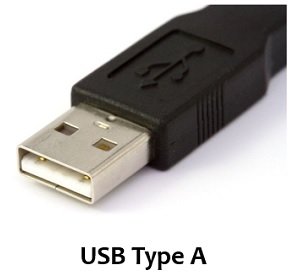USB-A and USB-C are the two most used categories in which USB cables are classified. The significant difference between USB-A and USB-C is based on the nature possessed by the two cables relative to their plug-in orientation. Basically, USB-A does not offer reversibility in terms of plug-in orientation within the port while USB-C exhibits reversible behavior and can be plugged in either way concerning the port orientation.
USB-A is also known as USB Type-A while USB-C is sometimes referred to as USB Type C.
Before proceeding further, one should have the idea about –
What is a USB?
USB stands for Universal Serial Bus cable that is known to be quite a successful personal computer interface ever. Through a USB, one can enable short distance communication between a computer and peripheral devices like mobile phones, printers, scanners, etc. The various electronic devices contain USB ports that allow devices to get connected with each other so that transfer of data can take place digitally over the USB cables.
In today’s world where technology is rapidly advancing the use of USB cables has shown a significant rise as it facilitates easy communication. USB cable came into existence in the year 1996 and since then we are using it as a standard to connect devices thereby supporting communication.
Nowadays all the devices have built-in USB ports where the USB cable is inserted and the two devices that are connected through the USB cable performs communication with each other. There are various versions of USB that are available in the market and the different versions are listed generally on the basis of speed that is offered by them.
Content: USB-A Vs USB-C
Comparison chart
| Basis for Comparison | USB-A | USB-C |
|---|---|---|
| Year of Invention | 1996 | 2014 |
| Size | Large | Comparatively small |
| Appearance | It appears wide. | It appears quite thin and therefore can be plugged-in in normal sized devices as well as thinner ones. |
| Data transfer rate | Slow | Comparatively fast |
| Plug-in reversibility | Not exist | Exist |
| Output power | Low | Quite high |
| Cost | Inexpensive | Comparatively expensive |
Definition of USB-A
It is the most commonly used type of connector in general and appears rectangular in shape and is known to be the most traditional type of USB. It is sometimes called ‘Standard A’. This type of cabling port is generally found in computer-like devices such as smart televisions, gaming consoles, DVD players, etc.
Though it is the traditional way of connecting two devices it is generally inserted in the host device due to this reason its ports are present in the devices mentioned above.
Definition of USB-C
It is the latest type of USB cable that is in current use and appears square in shape. The reason for its enormous popularity is the plug-in reversibility which it offers. It is a high-power cable that is suitable for high-speed data transfer operations.
Type C exhibits a quick charging ability to various portable popular devices than another type of USB. The symmetrical appearance of this cable makes its incorrect insertion impossible. It is generally found in portable devices like smartphones, tablets, etc.
Key Differences Between USB-A and USB-C
- A USB Type-A cable is different from a USB Type-C cable in various factors like shape, size, appearance, the rate with which data is transferred, etc. In terms of plug-in reversibility, USB-A and USB-C cables are mainly differentiated. The USB-A cable can be inserted within the port in a specific manner as it does not support plug-in reversibility.
As against, the insertion of USB-C cable does not require any specific orientation as it can be plugged in both ways due to the absence of any ‘up’ or ‘down’ side. This means that the cable will get inserted correctly when plugged-in in either way. - The physical appearance of USB-A is different from USB-C. According to the size of the two cables, it is said that USB-A is large size-wise whereas USB-C appears small.
- The rate with which data transfer takes place is quite fast through USB type C cable than the USB type A cable. USB-C cable transfers data at a rate of around 10 gigabytes/seconds.
- The output power provided by the USB-C is nearly 100 watts which are quite higher in comparison to the output power provided by the USB-A cable.
- The USB-A cable appears to be broader in comparison to the USB-C cable as the Type C is smaller in shape and is comparatively thinner.
Conclusion
From the above discussion, we can say that USB-C is more advantageous and versatile than USB-A as type C is invented after many technological advancements. However, besides all the advantages that USB-C cable offers it fails to offer interoperability. This means that it is not used in such connectors that are designed to connect to a specific company’s device only.


